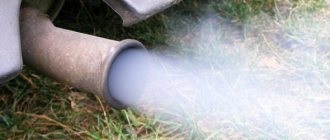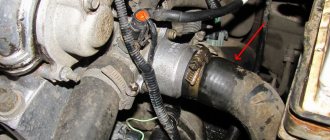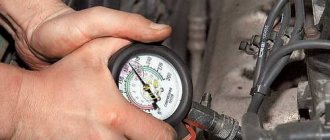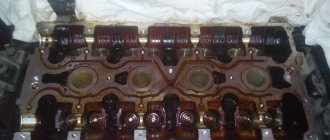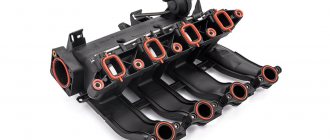Engine malfunctions can manifest themselves in different ways, from a barely audible clattering sound to a very noticeable indicator that lights up on the dashboard. There are also indirect signs indicating certain malfunctions and disturbances in the operation of the motor.
Today we'll talk about blue exhaust. About what blue smoke from the exhaust pipe means, why it appears and why it is dangerous for the engine.
Many motorists, when asked what color the exhaust should be or what color the exhaust is in their cars, are unlikely to be able to give a clear answer. The thing is that, as a rule, no one pays attention to this. But in vain, as practice shows, timely detection of a malfunction at an early stage allows you to prevent expensive engine repairs and save a lot of money.
Blue smoke appears
If you find blue smoke from the exhaust pipe of your car, then you should think about the reasons for its appearance.
The smoke itself is not a serious problem. But it becomes a symptom of more serious future breakdowns in the machine's systems. Therefore, it is important to immediately determine the reasons for its appearance in order to prevent troubles in advance, or to mentally prepare for the future replacement of any of the parts. This symptom can appear at any time of the year, winter or summer, at any temperature. You can also detect it at cold work, or when the power unit is warm.
In one of the previous articles in our magazine, we already wrote about the appearance of black smoke, its causes, consequences and correction. We also recommend reading that material. Now let's look at a different shade of exhaust.
Why does the engine smoke?
After several hours of the vehicle being idle and then starting the engine, in some cases you may notice the appearance of thick smoke from the exhaust system. This smoke can be white, gray or black. Smoke may either disappear or be present after further heating of the internal combustion engine. It should be noted that if the engine smokes after warming up, then this indicates a definite malfunction.
By the color of the exhaust, you can more accurately diagnose a breakdown, as well as identify the severity of the problem at various stages. In certain cases, the appearance of smoke is accompanied by:
- difficult starting of a cold engine;
- unstable operation of the engine at idle and under load;
- the speed on the tachometer may fluctuate;
- there is an increased consumption of fuel and engine oil;
- the engine loses power, etc.
There are also situations where smoking from a cold or hot engine is the only sign of a malfunction in the power unit.
Define color
First, you need to observe the color of the exhaust. An experienced driver is able to distinguish a whole palette of gases from the pipe. They can be either healthy, light gray, transparent, or unhealthy.
The latter include black smoke, dense white smoke, and blue smoke. You can also highlight a white-blue tint. It is also called gray. To imagine, think of what a city pigeon's feather, or ashes, looks like. This is that same blue smoke. It has its own causes and effects.
Now let's concentrate on blue. It may resemble the color of jeans, or the color of a gas lighter. It appears from the muffler when cold, at startup, at different air temperatures and in any season of the year.
Smoke from the exhaust pipe when starting the engine: white, black, blue exhaust color
As already mentioned, when starting the engine, smoke from the exhaust system can be of different colors, but smoke is not always a cause for concern. Let's start with the white exhaust color.
The fact is that after parking, condensation accumulates in the exhaust system. After startup, the condensate begins to evaporate, and the amount of smoke and its density are also affected by the outside temperature and air humidity (the colder and more humid, the thicker and longer the white smoke will persist). In cold weather, such smoking can be constant, that is, the installation smokes white regardless of the degree of heating of the internal combustion engine.
This malfunction appears as a result of engine overheating, breakdown or burnout of the cylinder head gasket, and the formation of cracks in the cylinder head and cylinder head in those places where the channels of the internal combustion engine cooling jacket pass.
In such a situation, you will need to remove the head, grind the mating plane if necessary, change the cylinder head gasket, check the head for leaks, repair cracks, etc.
- To confirm the diagnosis, unscrew the cap of the expansion tank of the cooling system with the engine running. Seething and bubbles will clearly indicate a breakthrough of gases into the cooling system, and the coolant level may also increase. After stopping the internal combustion engine, the indicated level in the tank decreases, part of the coolant enters the cylinders.
- Note that the liquid will not always bubble, especially if there are microdefects. In such a situation, you should be guided only by the color, condition and level of coolant.
- A burning smell, the presence of oil stains on the surface, a decrease in the level in the tank for no apparent reason, and a number of other indirect signs will indicate that liquid from the cooling system has entered the cylinders.
- It is also a good idea to take out the oil dipstick and unscrew the oil filler cap. The fact is that with intensive penetration of coolant into the combustion chamber, leaks occur from the space above the piston through the piston rings into the internal combustion engine crankcase.
The result is dilution and cloudiness of the engine oil, the appearance of a characteristic brownish emulsion. Let us add that with intense accumulation of coolant in the space above the piston, engine hydraulic shock may occur. For these reasons, strong white smoke is an alarming symptom and requires immediate elimination. In other words, it is better to stop operating the internal combustion engine until the problem is resolved.
Related Issues
Quite often, such exhaust from the muffler may be accompanied by some third-party problems. Let's list them:
- The motor is tripping. That is, it starts with a creak, or stalls at unusual moments, at high speeds or when starting
- Oil pressure jumps. You can track this symptom by the corresponding pressure sensor, or by a noticeable loss of compression during dynamics
- Reduced dynamics. Here you should rely on your driving sensations. You, like no one else, know how your car behaves, whether it is capable of overtaking at a certain speed and gear. Accordingly, if a decrease in characteristics is detected, then we add this to our list of symptoms
- Muffler drops. And not sedimentary ones, which can appear in the fall or spring, but splashes during gas or ignition. All you have to do is rev the gas a little and look for a puddle under the car.
If you find a couple, or even all of the accompanying symptoms, then you should immediately contact a car service and carry out diagnostics.
Unburned fuel
This guess will be confirmed by the presence of a pungent and pungent odor from the exhaust system. This will mean that the unburned fuel comes out along with the smoke in a vapor state.
Fuel may not burn out for various reasons. It is possible that the fuel is supplied too late or that some cylinder does not cope with its task and cannot burn diesel fuel.
As a rule, every effect has causes. The consequence, in this case, is unburned fuel and, as a result, the diesel smokes blue. So what are the reasons and malfunctions in diesel components that can lead to this?
Injection pump faulty
If the cause of blue smoke is a delayed injection, then you should pay attention to the wear of the high pressure fuel pump (HPF). It is easy to guess that fuel will not have time to burn out if it is supplied late
So, we have decided on one of the possible culprits. But why does this happen? The design and operation of the injection pump is quite complicated. To explain in simple words, the operation of this unit is based on the movement of special mechanisms for supplying fuel, which constantly rub and contact each other.
The fuel itself serves as a lubricant for the parts. Quite a tricky solution, because diesel fuel has a greasy structure. But with the arrival of winter, a transition to winter fuel is made.
It is called winter because its viscosity is reduced, namely, those same lubricating fractions are missing or their quantity is not enough to lubricate the “hardware” in the pump. This is what causes the fuel injection pump to wear out. And the wear of this part of the unit, in turn, along with the profile of the wave washer, causes a delay in fuel injection.
The mechanism is as follows: the fuel does not have time to heat up because it is supplied late, and the cylinder begins to work poorly with surges. As a result, the fuel that does not have time to burn is released outside in the form of blue smoke.
If you warm up the engine after driving a few kilometers, the bluish trail behind the car will disappear or decrease so much that it cannot be traced. But pump problems will not be corrected by this. When the engine is warm, even fuel supplied late has time to burn almost completely due to the high temperature background.
Poor engine compression
There are times when strong blue smoke comes out when starting the engine. And then after proper warming up the smoke disappears. This picture is quite common in the courtyards of our country, when there are columns of smoke, and the driver is running, clutching his head, and cannot understand what is happening.
The reason for this is low engine compression. Due to this defect, the temperature during compression does not reach the required value, so the fuel does not burn out completely. Even if the engine has one cylinder with low compression, the operation of such an engine is possible. But it will smoke until the overall temperature rises and the faulty cylinder begins to cope with the incoming fuel and ignite it.
Blue smoke can be caused by untimely injection or low compression. By the way, most modern diesel engines are equipped with a device on the fuel pump that performs early injection when the engine is still cold.
With this function, the engine runs harder, but the fuel has time to burn completely. The engine heats up, and the device returns fuel injection to its initial state, the engine begins to “purr” and becomes pleasant and soft to the ear.
DIY diagnostics
There is a simple, “old-fashioned” way of initial verification. Start the car and hold a piece of paper to the pipe. Preferably soft and absorbent. Hold it near the exhaust for a while and then look at the spots.
Watery spots that quickly evaporate indicate that water is entering the gas exhaust system. But oily, greasy streaks tell us that oil is getting into the exhaust. If along the way you notice a decrease in its pressure, then it is obvious that it is the lubricant composition that gives this color.
Now you need to determine where exactly the oil gets into the exhaust. There are three main suspects here:
- Intake manifold. When the suction valves open, oil may enter the engine. This usually happens along with air if you have an injector. The carburetor can throw it in along with the fuel. Then it will burn even more actively and the smoke will be brighter.
- Carter. If the piston rings break, lubricant may be sucked out of the crankcase.
- Valve box. There are seals on the inlet and outlet valves. When they wear out, they will leak lubricant.
Note that similar troubles can occur in both gasoline and diesel engines. Regardless of the type of fuel used, it is recommended to immediately go to repair the items listed above
Cold weather
The first reason for this phenomenon may be cold weather. As we understood from above, there is water vapor in the exhaust, there is no hiding from this, because it is in the air which is sucked in by the engine to create a fuel mixture. In cold weather, hot steam comes out of the muffler, instantly cooling, and here you have a whitish tint - or rather steam! Moreover, the lower the temperature, the stronger it will be noticeable. It's like steam coming out of your mouth.
I would also like to note that sometimes condensation forms in the muffler due to temperature differences. And when you start the engine, the muffler becomes hot and the water begins to evaporate. Thus, even in warm weather, white smoke may appear.
Condensation forms in the exhaust pipe due to frequent short runs, such as if you live close to work. The exhaust system does not warm up enough to evaporate all the water, and when it cools down, no evaporation occurs. Thus, the water level rises; I personally saw when about a liter was poured out. In order for it to evaporate and no longer form, you need to drive long distances at least once a week, 30 minutes or more. Or just warm up the car in the yard, then the cost will be significantly reduced.
How does the oil get there?
So, if we found greasy stains, then we understood why the smoke was coming out in that particular color. The next task is to find the specific culprit element. The list has already been compiled: intake manifold, crankcase or valve box.
But how does the lubricant get to these areas of the system? First of all, this is a consequence of wear and tear. The power unit operates under enormous pressure and at high temperatures. Consequently, iron parts regularly rub against each other with impressive force.
It is worth taking into account the age of the car and the mileage of its engine. The valve seals are clear, you just need to replace them. But with the crankcase and intake the situation is somewhat more complicated. After all, disruption of their operation indicates a lack of integrity in the piston group. As a result, the appearance of smoke can tell us about imminent trouble with the pistons. This is a fairly expensive repair, if not installing a new motor altogether. So, be careful.
Roughly speaking, the gaps that appear on the pistons cause a series of small deviations and the appearance of microcracks. It is into these cracks that the oil gets in, which, when burned in the unit, releases the bluish tint of the exhaust gases that we noticed.
Causes of engine smoking
The list of main faults that cause increased smoke formation includes:
- problems with the fuel supply system;
- wear of the cylinder-piston group;
- malfunctions of the gas distribution mechanism;
- malfunctions of the engine cooling system;
The appearance of smoke can be caused by incomplete combustion of the fuel-air mixture, failures in the combustion process, or the ingress of coolant from the cooling system or engine oil from the lubrication system into the combustion chamber. These faults can color the exhaust gases a certain color.
Additionally, it is worth considering that problems with one system can lead to the malfunction of other components and elements.
As an example, consider the ineffective operation of the engine cooling system. Insufficient cooling leads to engine overheating and destruction of the piston rings. Problems with the rings mean that oil starts getting into the cylinders and the engine smokes.
Doesn't burn fuel
Everything is clear with greasy stains and oil getting into the system. But what to do if the splashes are watery? This is a consequence of another problem, incomplete combustion of the fuel mixture in an internal combustion engine. And the smoke can be accompanied by a fairly distinct smell of fuel.
If gasoline does not burn, then the internal combustion engine is faulty. The main emphasis is on the cylinders. The detected lack of compression hints that they are doing a poor job. This means they are not in sufficient contact with the pistons and fall out of stroke. The first reason is destruction. Again, this is due to wear and tear on older engines and will cost you quite an expensive repair.
The second reason is low temperature. This is relevant if you find the same exhaust color during a cold start in winter. Insufficient oil temperature during warming up actively affects the insufficient combustion of gasoline or diesel. So there is only one way out, warm up the engine before the trip. Or have the cylinders repaired at a trusted auto repair shop.
Why does blue smoke come from the muffler and the reasons for its appearance?
While the car is new, few people pay attention to the condition of the exhaust gases and think that problems can be determined by their color. However, over time, especially if you do not pay due attention to vehicle maintenance, a more experienced neighbor in the garage will tell you about the appearance of a non-standard exhaust.
Knowing the reasons for this phenomenon will certainly help to avoid unpleasant moments in the future, especially when buying a used car.
The nature of the appearance of bluish smoke from a car exhaust pipe
An unusual color of exhaust gases always means that one of the vehicle's systems or components is faulty. Based on simple observation, it is possible to determine the breakdown of a certain mechanism.
If, for example, a white exhaust indicates the presence of coolant in the cylinders, and a black exhaust indicates a supersaturated mixture, then the main reason for blue smoke coming from the muffler is the combustion of oil in the internal combustion engine. This is where its name comes from - “oil”, which indicates serious problems with the engine.
At the same time, it must be taken into account that exhaust gases can have different shades, and this depends on many factors, including:
- degree of engine warm-up;
- composition and quality of motor oil;
- number of revolutions;
- external light conditions and ambient air humidity.
It is obvious to assume that “oily” exhaust is certainly accompanied by increased consumption of engine oil. This is actually true, for example, if at a standard consumption of 10 g per 100 km, blue smoke from the exhaust pipe appears only in transient modes, then exceeding the operating standards for oil consumption (ICE wear) will be expressed in the same way, only now in constant motion mode.
The nature of smoke and the degree of wear of the power unit
Experienced specialists, based on their own observations or the client’s descriptions of the characteristics of smoke, can with a high degree of probability guess the nature of the problem. Let's look at a few common cases:
- If the blue-white exhaust appears only when the engine warms up and gradually disappears as it warms up, then there is no reason to fear serious wear of the mechanisms. This effect is explained by the ability of parts to expand; when heated, the gaps decrease and oil leakage stops.
- In the case when, after warming up the power unit, smoking not only continues, but also intensifies, it can be argued that there is significant wear of the internal combustion engine elements. The reason is the following - the expansion is not enough to reliably seal the gaps and through them hot oil easily penetrates into the cylinders.
It goes without saying that blue or blue-white smoke from the muffler is accompanied by increased oil consumption. Therefore, monitoring its level using a dipstick is a necessary operation, which makes it possible to determine a breakdown in the early stages of its occurrence. Exceeding the consumption rate of lubricants should immediately alert the owner. In addition, on modern cars, due to the fact that they are equipped with a neutralizer that can purify gases, it is not always possible to determine the color of the exhaust even with increased oil consumption.
We must not forget about such a phenomenon as compression, the degree of which can sometimes be misleading. So, at first glance, wear of the CPG elements is quite often characterized by loss of compression and increased crankcase gas pressure. However, at the same time, a significant amount of oil seals the gaps and if they are not very far from standard, then the compression gauge readings may be normal, and sometimes closer to the upper limit.
The main reasons for the appearance of blue smoke from a car muffler
An owner who knows the slightest bit about how a car works knows that oil can get into the combustion chamber only in two ways:
- through piston rings;
- through the gap between the guide bushings and the valve stems.
From here we can already identify several groups of reasons why blue smoke appears from the exhaust pipe and oil consumption increases:
- change in cylinder geometry;
- piston ring defects;
- scoring on the cylinder surface;
- wear of the oil seal;
- valve leakage.
Let's take a closer look at some of the reasons from the list above.
Piston ring defects
One of the most common reasons leading to excessive consumption of lubricant. Compression rings wear out not only on the outer planes, but also on the end planes due to the high gas pressure in the cylinder. Moreover, worn grooves of the structure can create a “pump” effect, i.e. pump oil directly into the cylinder, even if the oil scraper rings are fully functional.
Violation of cylinder dimensions
Cylinders often wear out where the top ring stops when the piston reaches TDC. Also in the middle region of the cylinder, changes in its geometry towards an ellipse are observed. When carrying out diagnostics, it is important to accurately determine all deviations of the cylinder from the circle; this is the only way to get rid of the fact that blue smoke is coming from the muffler and excessive oil consumption is noticed. To do this, a series of independent measurements are made:
- in two vertical planes of the cylinder;
- in four levels horizontally of the node.
Cylinder defects
Unpleasant things like scuffs and scratches on the cylinder bore also allow oil to penetrate. The causes of such defects may be:
- abrasive particles due to unsatisfactory filtration of the lubricant;
- long-term parking of the car, as a result of which corrosion may occur on the rings and cylinders;
- non-compliance with power plant repair technology and the use of low-quality parts.
Non-standard fault options
When it comes to turbocharged engines, symptoms of discoloration of the exhaust may be associated with wear on the compressor rotor seals and bearings. At the same time, a defect in the seal of the front bearing of the turbocharger gives a characteristic picture, which is similar in external factors to wear of oil seals, including carbon deposits on the spark plugs. It is somewhat more difficult to determine the failure of the turbine seal due to the direct entry of oil into the exhaust system, where it burns out.
Quite rarely, but still occurs, a malfunction of the automatic transmission regulator membrane (if there is a vacuum load sensor). This also leads to a phenomenon such as blue smoke from the exhaust pipe; the defect can be determined by the condition of the spark plugs, which are filled with oil, as well as the splashing of lubricant from the spark plug mounting holes. Box oil has a reddish color and a specific smell - this is what will help diagnose a breakdown.
What's wrong with the internal combustion engine
To make it easier for you to deal with the breakdown, we will provide a list of specific breakdowns that can cause all of the above troubles.
- Damaged oil scraper and compression rings. Large gaps appear, because of this, gas mixtures and oil compositions come into contact.
- Development of piston grooves. When they expand, the seal falls off. As a result, the piston works like a pump, pumping lubricant into the cylinder.
- Destruction of intergroove bridges. There is such a thing as thermal fatigue of iron. And yes, this is again due to the old motor. Additives are suitable as a temporary measure, but not for long.
- Coking of rings. Soot appears, due to which the contact of the mechanisms is lost, the tightness is broken, niches are formed, which are filled with motor oil.
- Destroyed piston geometry. That is, he just moves unevenly. It may appear after a minor accident or with poor delivery of the internal combustion engine if you ordered it from afar.
- Did you change the lubricant irregularly or use a bad brand? Chips and cracks appeared, through which this same lubricant leaked into the cylinder.
- Crooked installation of rings. Without compaction, or simply in violation of the geometry. As they say, I should tear off this master’s hands. Find someone else who will put them straight. Although, most likely, by that time they will need to be completely replaced.
So, we have looked at the main reasons for the appearance of bluish exhaust from your car’s muffler. Remember that if symptoms are detected, go straight to a car service center, so as not to “get money” from expensive subsequent repairs.
Breaking
Usually the symptoms are as follows: - no matter what the weather and temperature, whether the engine is warmed up or not, a very thick white exhaust comes out of the exhaust pipe, and the coolant level is constantly falling (you can read how to find out here ), you add a new batch of fluid almost every day. The revolutions constantly “dance”, from 800 to 1200.
I’ll tell you guys right away – nothing good. You need to go to the service station and the sooner the better. If you wait, you can ruin your unit, and it’s not far from the “ capital ”.
Reason: - the whole point is that the coolant enters the combustion chamber, after which it exits into the muffler with the exhaust. This is very dangerous, because it also mixes with oil, its properties decrease, and after eliminating the problem, it is advisable to change it.
Why does this happen? And how can she get there?
It's all about the design of the motor. As you know, it consists of a block and an upper head (where the “camshaft” is located), between them there is a gasket, the design must be sealed - since coolant circulates in the block and the “head”, which removes excessive overheating. It should be noted that the liquid also passes through the gasket (there are special grooves there).
If everything is normal, there are no leaks - antifreeze cannot get into the cylinders. But if the cylinder head is installed incorrectly (poorly screwed in) or if it is damaged, small deflections are possible, through which liquid begins to ooze. It is this that enters the combustion chambers, immediately evaporating and turning into thick white steam.
Therefore, you need to clearly know what is happening to your engine - is regular steam or all the antifreeze is leaving. Let's watch a useful video.
You can diagnose the breakdown yourself; there is one “old-fashioned” method.
1) Warm up the engine to operating temperature, it would be good after a short mileage.
2) Take a blank piece of paper and apply it to the exhaust pipe. Without covering it completely, about half. Hold for 10 – 15 seconds.
3) We look at the paper, if it is wet as if from water, there is nothing to worry about. It's just water. If the paper is oily, like after butter, this is bad! This means that antifreeze or antifreeze is leaking into your system. You need to go to the service station, don’t delay.
Let's watch a short video.
